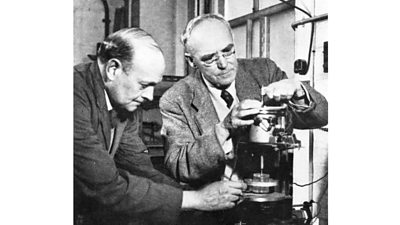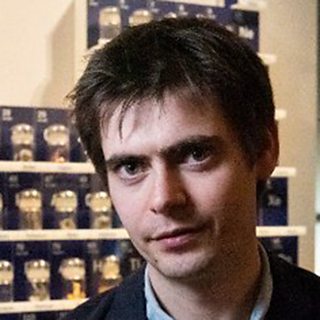From demonstration-rich lectures to journalistic documentaries and fiery debates, science television has taken many forms over its 90-year lifetime at the ±«Óãtv. Discover the pioneering people who have shaped ±«Óãtv science television through newly released interviews and programme extracts.
Science television programmes are almost as old as television broadcasting itself. Just 7 weeks after the ±«Óãtv Television Service was launched on 2 November 1936, a lecture on ‘why ships roll in a rough sea’ by the physicist Geoffrey Ingram Taylor was broadcast from the ±«Óãtv’s Alexandra Palace Studios.

Taylor’s 15-minute lecture, which according to the Radio Times featured ‘actual experiments’, was based on his forthcoming Royal Institution Christmas Lectures that year. The broadcast was the ±«Óãtv’s first science television programme, at a time when there was only one channel with just 2 hours of programming a day.
Under Mary Adams, a scientist herself before becoming a producer, ±«Óãtv science television programmes became a regular feature in the late 1940s. At this time, programmes were largely studio based – a notable exception being a television outside broadcast from the Royal Institution in January 1949 based on the Christmas Lectures series The Mind at Work and Play – a television tradition that continues to this day.
Television lectures, or ‘Talks’ in ±«Óãtv departmental parlance, were the dominant form of science programme in this early period through to the mid-1950s. The big change to science programming was a shift towards , a television department that captured the excitement of live events taking place outside the studio, such as the and the 1953 .
The key figure to usher in an era of science outside broadcasts was the producer Aubrey Singer, who witnessed the potential of these kinds of programmes during a hugely-ambitious television programme, The Restless Sphere (1957), which told a global scientific story of the International Geophysical Year. Presented by the Duke of Edinburgh from the Royal Society, The Restless Sphere featured both live and telecined footage of scientific experiments from around the world – it was the most expensive programme the ±«Óãtv had produced to that date.
Here is an excerpt of an interview with Aubrey Singer talking about early science television, from the ±«Óãtv’s Oral History archive, released for the first time.
Following The Restless Sphere, Aubrey Singer launched the innovative series Eye on Research (1959-1962) that took television cameras to laboratories. He was soon given his own new department for outside broadcast science television programmes, leading ±«Óãtv science programming into the 1960s, and responsible for introducing series such as Horizon (1964) and Tomorrow’s World(1965).
A new channel, and a new science series: Horizon
When the second channel, ±«Óãtv Two, arrived in 1964, it presented new opportunities for science programming, which Singer’s department eagerly took up.
±«Óãtv Two was aimed at a less mainstream audience to ±«Óãtv One, and so could host more ‘serious’ science programming, as Singer phrased it.
The idea for Horizon (1964 -) came a few years earlier when it was decided to discontinue Eye on Research. It was conceived as a magazine-style programme, dealing ‘with scientific topics which have philosophical impact on other fields of the arts and the humanities’.
Among the more serious, hard topics of the first Horizon series was Strangeness Minus Three, on the recent discovery of a subatomic particle. There were also lighter ones, including a Christmas special on Science, Magic and Toys.
This extract, featuring the chemist George Porter, who was then about to take over as Director of the Royal Institution, harked back to an earlier television format: the scientific lecture. It juxtaposed a dramatised version of Faraday’s 1861 Christmas Lectures, with an updated version given by Porter.
Porter wasa close ally of Horizon’s first editor, Philip Daly (who produced The Restless Sphere and Eye on Research under Singer). He would become a prominent scientific voice in ±«Óãtv circles in the 1960s and 1970s.
The ±«Óãtv – a propagandist for science?
From the late 1960s ±«Óãtv television producers began to make programmes with a more critical, journalistic take on science, with Horizon and a new sociologically-informed documentary series called Towards Tomorrow tackling controversial issues such as the environment, organ transplantation and chemical and biological warfare.
The scientific establishment noticed and were not happy. In a 1968 meeting of a group set up to enable dialogue between eminent scientists and the ±«Óãtv science staff, George Porter complained to Aubrey Singer that future programmes were focussed on ‘the bad rather than the good effects of science and technology on everyday life’.
Singer retorted ‘he did not see the ±«Óãtv’s role as a propagandist... his intention was to bear witness to the times’.
One of Singer’s producers who exemplified this style of TV science journalism was Peter Jones, who came from the ITV network as a documentary maker. This extract is from the collection, a project to tell the story of the ±«Óãtv’s longest-running flagship science series through its key people.
As Jones later recalled, the most controversial programme he did was a 1973 Horizon called Science is Dead, Long Live Science.
The first third of the programme focussed on American scientists who had become disillusioned with the scientific establishment, featuring segments about the use of napalm in Vietnam, environmental impacts of the coal industry, and activist scientists. The rest of the programme followed new ‘drop-out’, counter-cultural communities of scientists, attempting self-sufficiency based on ecological thinking and renewable energy – then novel ideas.
‘It actually shook a lot of people,’ Jones remembered, ‘senior people in the ±«Óãtv came down on me like a ton of bricks’. The New Scientist was full of praise for it scooping the print media on alternative technology communities, while Nature dismissed it as the epitome of anti-science.
Porter was furious. He confessed to the programme’s researcher, Fiona Holmes, he watched it ‘to the bitter end,’ deriding the ‘constipated fibreglass windmill’. He asked ‘does the team which produced this edition of the ±«Óãtv’s main serious science programme really have such a disrespect for science?’
While the programme’s depiction of ‘hippy’ scientists chanting around fires and rejections of modern technological society annoyed figures like Porter, the thing that really rattled the scientific establishment was the programme’s critique of the claim that science is neutral, objective, and removed from social values.
A ‘golden era’ – changing attitudes, challenging science.
Like newspaper journalism, the Editor was a key role in science TV series like Horizon and Tomorrow’s World. This was someone who determined what subject programmes would cover, who would produce them and how they would be made.
It was not until 1990 that the ±«Óãtv’s flagship science series, Horizon, appointed a woman to the position of Editor – Jana Bennett. While there had been influential women in the Science and Features department before, such as the pioneering producer Mary Adams and the long-running Tomorrow’s World presenter Judith Hann, a male-dominated culture had persisted for several decades.
So Jana Bennett,who had worked for over a decade in news programming, had attitudes to change when she joined the department in 1990. Here, in this recently-released extract from the Horizon at 50 collection, Bennett talks about these challenges.
According to Bennett, it was a ‘golden era’ of science television, and women were crucial to that success – at around the same time as she became Horizon editor, Dana Purvis and Susan Spindler were appointed editor of Tomorrow’s World and QED.
In 1994 Bennett was promoted to ±«Óãtv's Head of Science. That year saw the launch of the inaugural British Science Week, set-up to promote the ‘public understanding of science’. For the ±«Óãtv’s programming for this week, Bennett was Editor for a one-off late-night science debate series called The Exploratory.
Televised from the former Bristol science centre of the same name, The Exploratory series featured 40 ‘scientific experts’ debating social issues around science. The series twist was that participants used multimedia devices to select and screen clips from the ±«Óãtv’s archives of science television to illustrate their arguments.
The third programme, the Bride of Frankenstein, explored science and gender. The following extract illustrates how a television clip became a jumping point for a heated exchange on whether gender values are ingrained within the framework of science.
Like the other programmes in the series, Bride of Frankenstein featured a mix of scientists and academics who study science, such as sociologists, historians, with this episode featuring scholars like Hilary Rose and Anne Fausto-Sterling who pioneered feminist studies of science, and Ziauddin Sardar, historian of Islamic science. As the extract shows, they were pitted against (male) scientists who held very different values, and at times were contemptuous of the ‘feminist viewpoint’ as they labelled it.
The series was daring and progressive in its choice of topics and participants, staging for a television audience academic critiques of science that would find themselves at the heart of the so-called ‘Science Wars’ in the mid-1990s.
It was also innovative in its use of early interactive multimedia technology. The series producer, Martin Freeth, was a pioneer in this area at the ±«Óãtv. This freshly released clip is another from the Horizon at 50 collection.
Science television today
The legacy of Singer’s outside broadcasts, Jones’ science journalism, Bennett’s progressive programming, and Freeth’s multimedia vision can be witnessed in the oldest of TV science traditions today: the Royal Institution Christmas Lectures.
The 2020 Christmas Lectures broke from tradition in several ways. Covering climate science, they featured three lecturers instead of the usual one; and an audience watching and interacting with the televised lectures remotely, through streaming multimedia technology – first used on television in The Exploratory.
Chris Jackson, one of the three 2020 lecturers, became the first black scientist to give the Christmas Lectures. Receiving online abuse following the lectures, Jackson became an important voice in the conversation about race and science:
"You are not simply putting things on the table at the front of the lecture theatre and pointing at it and making it bang... it is not just about facts and conveyance of numbers and chemical equations, it’s about all of the messy stuff that goes on in science as well – and race and racism, misogyny, and homophobia and transphobia are all part of that discussion."
±«Óãtv television continues a long tradition of holding a mirror up to science through a societal lens, featuring voices who are challenging long-held values and attitudes.
Written by Rupert Cole, Curator at the Science Museum Group, London.
Further reading
Tim Boon, Films of Fact: A History of Science in Documentary Films and Television (Wallflower Press: 2008).
Tim Boon, The televising of science is a process of television: establishing Horizon, 1962-1967, (BJHS: 2015).
Jean-Baptiste Gouyon and Tim Boon, The Origins and Practice of Science on British Television in The Routledge Companion to British Media History, edited by Martin Conboy and John Steel, (Routledge: 2015).

